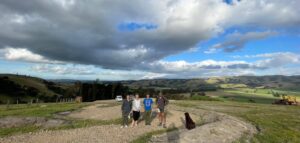The Cat star is one of our favourite stars. It is Canopus, the second brightest star in the sky. Canopus is significant in many cultures; visible with the unaided eye from twilight, it is a circumpolar star from New Zealand, which means it is always in the sky, doing circles around the South Celestial Pole. We talked about Canopus, its significance in many cultures, and how it became the Cat Star.
The first part of the night was very dark, with exceptional stargazing conditions. Processing the photos from the night, we also found a faint aurora.

The Moon came up just in time for our second stargazing session, making a great background for some excellent photos.





We saw some nebulae – Spiral Nebula in Musca, M 42 Orion’s Nebula; some star clusters – Omega Centauri, 47 Tucanae, Pearl Cluster, Jewel Box; a galaxy – Sculptor; some planets – Mars, Jupiter and its Galilean moons, and a comet C/2022 E 3 ZTF, just to list a few. We also looked at the Moon.


Access the rest of the photos here.
We hope you enjoyed your Star Safari and we look forward to seeing you back.






